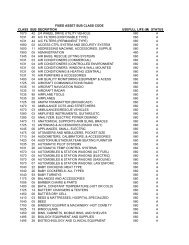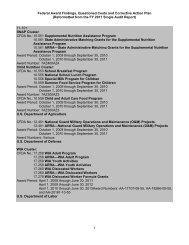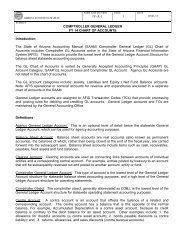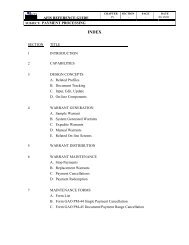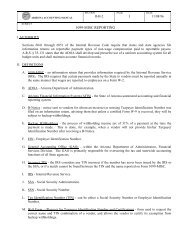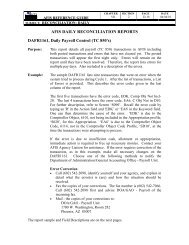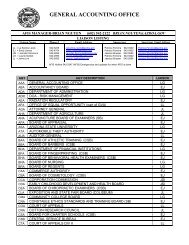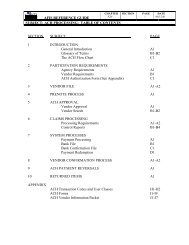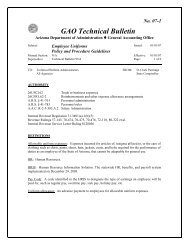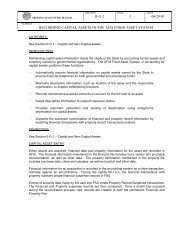Technical Bulletin 13-03 - General Accounting Office
Technical Bulletin 13-03 - General Accounting Office
Technical Bulletin 13-03 - General Accounting Office
You also want an ePaper? Increase the reach of your titles
YUMPU automatically turns print PDFs into web optimized ePapers that Google loves.
Subject:<br />
GAO <strong>Technical</strong> <strong>Bulletin</strong><br />
Arizona Department of Administration <strong>General</strong> <strong>Accounting</strong> <strong>Office</strong><br />
Revised Statewide Formatting Guidelines<br />
for SEFA Reporting<br />
<strong>13</strong>-<strong>03</strong><br />
Issued: 08/19/<strong>13</strong><br />
Manual Section(s): N/A Effective: 08/19/<strong>13</strong><br />
Supersede(s): <strong>Technical</strong> <strong>Bulletin</strong> No. 10-08 Page: 1 of 7<br />
TO:<br />
<strong>Technical</strong> <strong>Bulletin</strong> Administrators<br />
All Agencies<br />
FROM:<br />
D. Clark Partridge<br />
State Comptroller<br />
AUTHORITY<br />
A.R.S. § 35-101<br />
A.R.S. § 41-7<strong>03</strong><br />
A.R.S. § 41-722<br />
Definitions<br />
Duties of director<br />
Powers and duties relating to finance<br />
DEFINITIONS<br />
AFIS: The Arizona Financial Information System. Arizona State Government’s principal<br />
automated accounting system.<br />
Agency: Any department, authority, board, commission, council, administration, court, registrar,<br />
office, institution, or other entity in the Executive, Legislative, or Judicial branch of Arizona<br />
State Government. In contexts that are directive in nature, the use of the term “agency” may<br />
imply that employee or those employees within the organization—such as the agency head, the<br />
CFO, etc.—responsible for carrying out the procedures under consideration.<br />
Agency head: The chief executive officer of any agency.<br />
ARRA: The American Recovery and Reinvestment Act of 2009; also commonly known as the<br />
Recovery Act.<br />
Award: The payment of monies or the commitment to pay monies through a grant to support a<br />
Federal program.<br />
Beneficiary: An entity, most frequently an individual, that ultimately derives the benefits of the<br />
program the award is intended to fund.<br />
CFDA: Catalog of Federal Domestic Assistance. The CFDA is a compendium of financial and<br />
nonfinancial assistance programs, i.e., grants, administered by departments and establishments of<br />
the Federal government. The CFDA can be found online at www.cfda.gov.<br />
CFDA Number: A unique number, in the format of nn.nnn, assigned by the OMB, identifying a<br />
Federal grant. The CFDA Number is used to track all domestically funded Federal assistance<br />
programs.
GAO <strong>Technical</strong> <strong>Bulletin</strong> <strong>13</strong>-<strong>03</strong><br />
Subject:<br />
Revised Statewide Formatting Guidelines<br />
for SEFA Reporting<br />
Issued: 08/19/<strong>13</strong><br />
Manual Section(s): N/A Effective: 08/19/<strong>13</strong><br />
Supersede(s): <strong>Technical</strong> <strong>Bulletin</strong> No. 10-08 Page: 2 of 7<br />
CFO: Chief financial officer; that person principally responsible for managing the accounting<br />
operations of an agency.<br />
Closing package: A set of instructions, published annually by the GAO, to assist agencies in<br />
satisfying their year-end financial reporting obligations.<br />
Cluster: Cluster of programs. A group of closely related programs that share common compliance<br />
requirements. Clusters are identified by the OMB in its Compliance Supplements.<br />
Compliance Supplement: A publication that augments OMB Circular A-<strong>13</strong>3 by detailing the<br />
important provisions of Federal Assistance Programs. The Compliance Supplement is frequently<br />
updated by the OMB. As of the publication of this technical bulletin, the most recent<br />
Compliance Supplement is that dated June 20<strong>13</strong>. Compliance Supplements are available on the<br />
OMB website at http://www.whitehouse.gov/omb/circulars/.<br />
Conduit: A State agency functions as a conduit when it receives Federal grant monies but<br />
transfers these funds, essentially intact, to another State agency. In its role as conduit, the agency<br />
has reporting but no oversight obligations.<br />
Contract number: A unique number identifying an agreement to perform certain services on<br />
behalf of the Federal government in exchange for funding.<br />
Direct award: An award that is intended to be spent by the recipient in support of its own<br />
operations, rather than to be passed through to a subrecipient.<br />
Entity: Any individual, partnership, corporation or unit of government that can engage in any<br />
form of economic activity.<br />
Expenditures: The amount of Federal grant monies reported as spent by a recipient.<br />
Expenditures include both those monies spent by the recipient in direct support of an activity and<br />
those amounts passed through to subrecipients.<br />
Federal grant: An award of financial assistance, including cooperative agreements, in the form<br />
of money, or property in lieu of money, from the Federal government, either directly or indirectly<br />
to an eligible recipient or subrecipient.<br />
GAO: The Arizona Department of Administration, <strong>General</strong> <strong>Accounting</strong> <strong>Office</strong>.<br />
Grant: A sum of money given by one governmental entity to some other entity for the purpose of<br />
achieving some goal or supporting some program.<br />
Identifying Number: A number assigned to an award by the GAO, absent a CFDA number<br />
having been assigned.
GAO <strong>Technical</strong> <strong>Bulletin</strong> <strong>13</strong>-<strong>03</strong><br />
Subject:<br />
Revised Statewide Formatting Guidelines<br />
for SEFA Reporting<br />
Issued: 08/19/<strong>13</strong><br />
Manual Section(s): N/A Effective: 08/19/<strong>13</strong><br />
Supersede(s): <strong>Technical</strong> <strong>Bulletin</strong> No. 10-08 Page: 3 of 7<br />
Indirect award: An award that is intended to be passed through to a subrecipient rather than to be<br />
spent by the recipient in support of its own operations.<br />
OMB: The United States <strong>Office</strong> of Management and Budget. A unit of the Federal government,<br />
a division of the White House, involved in the administration of Federal monies.<br />
OMB Circular A-<strong>13</strong>3: A publication of the OMB, entitled “Audits of States, Local Governments<br />
and Non-Profit Organizations,” that sets forth standards for obtaining consistency and uniformity<br />
with respect to the expending of Federal awards. OMB Circulars may be found by following the<br />
links listed on OMB website at http://www.whitehouse.gov/omb/.<br />
Pass-through grantor: A pass-through activity involves the transfer of Federal grant monies from<br />
one entity to another when the entity to which the monies are transferred is not the final recipient<br />
of the monies. An entity that fulfills no performance role with respect to grant monies received<br />
and transfers Federal grant monies to another entity is referred to as a pass-through grantor.<br />
Pass-through recipient agency: A pass-through activity involves the transfer of Federal grant<br />
monies from one entity to another when the entity to which the monies are transferred is, except<br />
for vendors or individuals, the final recipient of the monies and fulfills a performance role with<br />
respect to such monies. An agency that is the final recipient is referred to as a pass-through<br />
recipient agency; a pass-through recipient agency receives its funding, directly or indirectly, from<br />
a pass-through grantor.<br />
Prime recipient: The primary awardee or legal entity receiving a grant, contract, or cooperative<br />
agreement. A prime recipient may expend funds in support of its own programs or act as a<br />
conduit, disbursing grant monies to another agency within the same governmental structure. The<br />
prime recipient has the responsibility of monitoring the use of all the funds it receives under<br />
Federal grants or contracts, whether it uses the funds itself or acts as a conduit to other agencies<br />
or transfers such funds to subrecipients.<br />
Program title: The official name by which a Federal program and its related grant or contract is<br />
known.<br />
Provided to subrecipients: That portion of grant expenditures provided to subrecipients; for<br />
reporting purposes, it is always an amount equal to or less than expenditures.<br />
R&D Cluster: Research and Development Cluster; one of the principal categories of program<br />
clusters.<br />
Recipient: Any entity—prime recipient, subrecipient, subsubrecipient—other than a vendor or<br />
beneficiary that receives Federal grant or contract monies.<br />
SEFA: Schedule of Expenditures of Federal Awards. A list of the various Federal programs<br />
under which a governmental entity has expended awards during the entity’s fiscal year.
GAO <strong>Technical</strong> <strong>Bulletin</strong> <strong>13</strong>-<strong>03</strong><br />
Subject:<br />
Revised Statewide Formatting Guidelines<br />
for SEFA Reporting<br />
Issued: 08/19/<strong>13</strong><br />
Manual Section(s): N/A Effective: 08/19/<strong>13</strong><br />
Supersede(s): <strong>Technical</strong> <strong>Bulletin</strong> No. 10-08 Page: 4 of 7<br />
Single Audit: An audit conducted under the provisions of the Single Audit Act.<br />
Single Audit Act: A law designed to improve the management of Federal funds provided to state<br />
and local governments.<br />
Subrecipient: A non-Federal, non-State entity (a for-profit organization, not-for-profit<br />
organization, or a governmental entity) that expends Federal monies received from another entity<br />
to carry out a Federal program or the terms of a grant or contract, other than an individual who is<br />
a beneficiary of such program. For reporting purposes under ARRA, State universities are<br />
required to be treated as subrecipients for pass-through activities; for all other purposes, State<br />
universities are pass-through recipient agencies for pass-through activities. Subrecipients, under<br />
the terms of a governing contract or grant agreement, support the performance of some<br />
substantive portion of a project or program. The terms, conditions and performance obligations<br />
of a Federal grant carry forward to a subrecipient; such terms and conditions include, but are not<br />
limited to:<br />
° Meeting the objectives of the underlying Federal program.<br />
° Making eligibility determinations.<br />
° Enforcing compliance with Federal guidelines.<br />
In summary, a subrecipient is largely responsible for the results of a program or project.<br />
Vendor: A vendor is responsible for providing goods or services necessary to conduct a program<br />
or project, but is not responsible for the results of the program or project. A vendor:<br />
° Provides goods and services, as specified by purchase order or contract.<br />
° Provides goods and services that may be ancillary to the operation of a program.<br />
° Provides similar goods or services to many different purchasers.<br />
° Competes with other vendors providing similar goods or services.<br />
In summary, a vendor is not responsible for the results of a program or project.<br />
INTRODUCTION<br />
The SEFA is a report prepared in connection with a Single Audit. The SEFA is subject to<br />
critical comment by auditors conducting the Single Audit. In the State of Arizona, the GAO is<br />
responsible for compiling the statewide SEFA from information contained in AFIS, from<br />
schedules provided by larger agencies and those agencies that administer a significant number of<br />
Federal grants or a significant amount of Federal monies, and from the financial statements of<br />
those agencies which are individually audited.
GAO <strong>Technical</strong> <strong>Bulletin</strong> <strong>13</strong>-<strong>03</strong><br />
Subject:<br />
Revised Statewide Formatting Guidelines<br />
for SEFA Reporting<br />
Issued: 08/19/<strong>13</strong><br />
Manual Section(s): N/A Effective: 08/19/<strong>13</strong><br />
Supersede(s): <strong>Technical</strong> <strong>Bulletin</strong> No. 10-08 Page: 5 of 7<br />
In order to reduce the number of deficiencies identified during the statewide Single Audit, to<br />
better comply with the updated provisions of the Single Audit Act, and to increase the efficiency<br />
in compiling the statewide SEFA, the revised formatting guidelines set forth below must be<br />
adhered to by any agency submitting an agency SEFA to the GAO.<br />
POLICY & PROCEDURES<br />
1. Any agency that produces separately audited financial statements must, nonetheless, submit<br />
its agency’s SEFA to the GAO using the guidelines set forth in these policies and<br />
procedures.<br />
2. In the event of conflict, these policies and procedures supersede any formatting instructions<br />
contained in the GAO closing package available on the GAO website at the time of this<br />
technical bulletin’s publication.<br />
3. Statewide formatting guidelines for SEFA reporting:<br />
a. All grants should be listed in, first, numerical and, then, alphabetical order by, as<br />
applicable, the grant’s CFDA number or identifying number, except as follows:<br />
i. Clusters are to be listed first, before any individual grants, under the awarding Federal<br />
agency.<br />
ii. Clusters that involve multiple Federal agencies (i.e., Student Financial Aid Cluster,<br />
Research and Development (R&D) Cluster) are listed after the listing of programs<br />
that relate only to individual Federal agencies.<br />
b. For grants that share a CFDA number or an identifying number, all direct awards should<br />
be listed first, followed by any indirect awards (i.e., those that include pass-through<br />
information in the title). The direct and indirect awards should be listed alphabetically by<br />
program title.<br />
c. There should be precise agreement between the five-digit CFDA number and program<br />
title to be used on the SEFA and the CFDA number and program title listed in the<br />
CFDA. Absent precise agreement between CFDA numbers or program titles, the GAO<br />
should be contacted. The GAO, working with the agency, will consult the CFDA<br />
Historical Index of Programs to ascertain whether the program might be known under a<br />
different CFDA number or program title.<br />
d. When it has been determined that no CFDA number has been assigned to a program, the<br />
two-digit identifier of the awarding Federal agency, a period, and the Federal contract<br />
number (nn.nnnnn) are to be used to identify the program. When there was no Federal
GAO <strong>Technical</strong> <strong>Bulletin</strong> <strong>13</strong>-<strong>03</strong><br />
Subject:<br />
Revised Statewide Formatting Guidelines<br />
for SEFA Reporting<br />
Issued: 08/19/<strong>13</strong><br />
Manual Section(s): N/A Effective: 08/19/<strong>13</strong><br />
Supersede(s): <strong>Technical</strong> <strong>Bulletin</strong> No. 10-08 Page: 6 of 7<br />
contract number, the two-digit Federal agency identifier, a period, and the word<br />
“Unknown” are to be used (nn.Unknown).<br />
Example: If the award under consideration has no Federal contract<br />
number but was received from the U.S. Department of of Education<br />
(USDOE), the grant’s identifier would be listed as 84.Unknown, since<br />
84 is the prefix associated with the USDOE.<br />
e. In the case of an award being distributed by a conduit agency, conduit agency’s name<br />
should be listed as the pass-through grantor.<br />
i. Except with respect to the R&D Cluster, a State agency should not be listed as a<br />
conduit.<br />
ii. In the case of the R&D Cluster, a grant title is frequently not available. Therefore,<br />
the State conduit agency is listed since this is the only means of identifying the grant.<br />
f. The applicable CFDA numbers of Clusters are listed in the OMB Circular A-<strong>13</strong>3<br />
Compliance Supplement. Only the CFDA numbers listed in the Compliance Supplement<br />
should be used.<br />
g. Programs that are part of a Cluster should be reported as part of the appropriate Cluster.<br />
The CFDA numbers of such programs should not be improperly excluded from the<br />
Cluster nor should they be listed elsewhere.<br />
h. Federal agency titles (whether agency or sub-agency) listed in the SEFA should exactly<br />
match those set forth in the CFDA. Federal agency titles should be printed entirely in<br />
capital letters, underlined, centered, and should appear before the commencement of<br />
each new numerical sequence of CFDA numbers or identifying numbers (each new<br />
sequence being marked by the initial two digits of a separate Federal agency).<br />
i. Cluster titles should exactly match those included in the most recent Compliance<br />
Supplement.<br />
j. Each Cluster should be preceded by a header containing the Cluster’s name. The header<br />
should be in mixed upper and lower case (the first letter of each word in a title should be<br />
capitalized, except for words such as and, for, of, the, and to), underlined, and leftjustified.<br />
k. A total of expenditures for the State’s fiscal year should be presented for each Federal<br />
agency. The total description should match the Federal agency’s name (e.g., for the<br />
Department of Commerce, the total description should be “Total Department of<br />
Commerce”).
GAO <strong>Technical</strong> <strong>Bulletin</strong> <strong>13</strong>-<strong>03</strong><br />
Subject:<br />
Revised Statewide Formatting Guidelines<br />
for SEFA Reporting<br />
Issued: 08/19/<strong>13</strong><br />
Manual Section(s): N/A Effective: 08/19/<strong>13</strong><br />
Supersede(s): <strong>Technical</strong> <strong>Bulletin</strong> No. 10-08 Page: 7 of 7<br />
l. Guidelines for the use of hyphens and dashes:<br />
i. If the two words are to be joined because they are somehow related to or describe<br />
each other (e.g., long-term), a hypyhen (-) should be used.<br />
ii. If the elements, such as the parts of a title, are to be separated (e.g., Special<br />
Education—<strong>Technical</strong> Assistance) a dash (—), also known as an m-dash, should be<br />
used.<br />
iii. The use of hyphens and dashes should be appropriate and consistent throughout.<br />
m. Guidelines for contract numbers:<br />
i. The contract number should be listed as the pass-through grantor identifying number.<br />
ii. If multiple contract numbers are listed, each number should be separated by a comma<br />
and one space.<br />
n. In the SEFA report, the amount listed in the Expenditures column is to include all<br />
expenditures, including amounts passed through to other entities; the amount listed in the<br />
Provided to Subrecipients column represents a portion of the Expenditures amount.<br />
o. Refer to the Single Audit reports on the GAO Website, http://www.gao.az.gov, for<br />
examples of appropriate report formatting. It would be of particular value to an agency<br />
to review, taking into account the changes discussed herein, how the reporting of its own<br />
grants were formatted in prior years’ SEFAs.<br />
ON-LINE AVAILABILITY<br />
Copies of all <strong>Technical</strong> <strong>Bulletin</strong>s and many GAO Forms are available for viewing and<br />
downloading from the <strong>General</strong> <strong>Accounting</strong> <strong>Office</strong> Website located at:<br />
AREAS IMPACTED<br />
All State agencies.<br />
CONTACTS<br />
http://www.gao.az.gov/<br />
If you have any questions concerning this <strong>Technical</strong> <strong>Bulletin</strong>, please contact your GAO Liaison.<br />
You may also e-mail questions or comments concerning State policy and procedure to us at:<br />
gaopolicy@azdoa.gov



